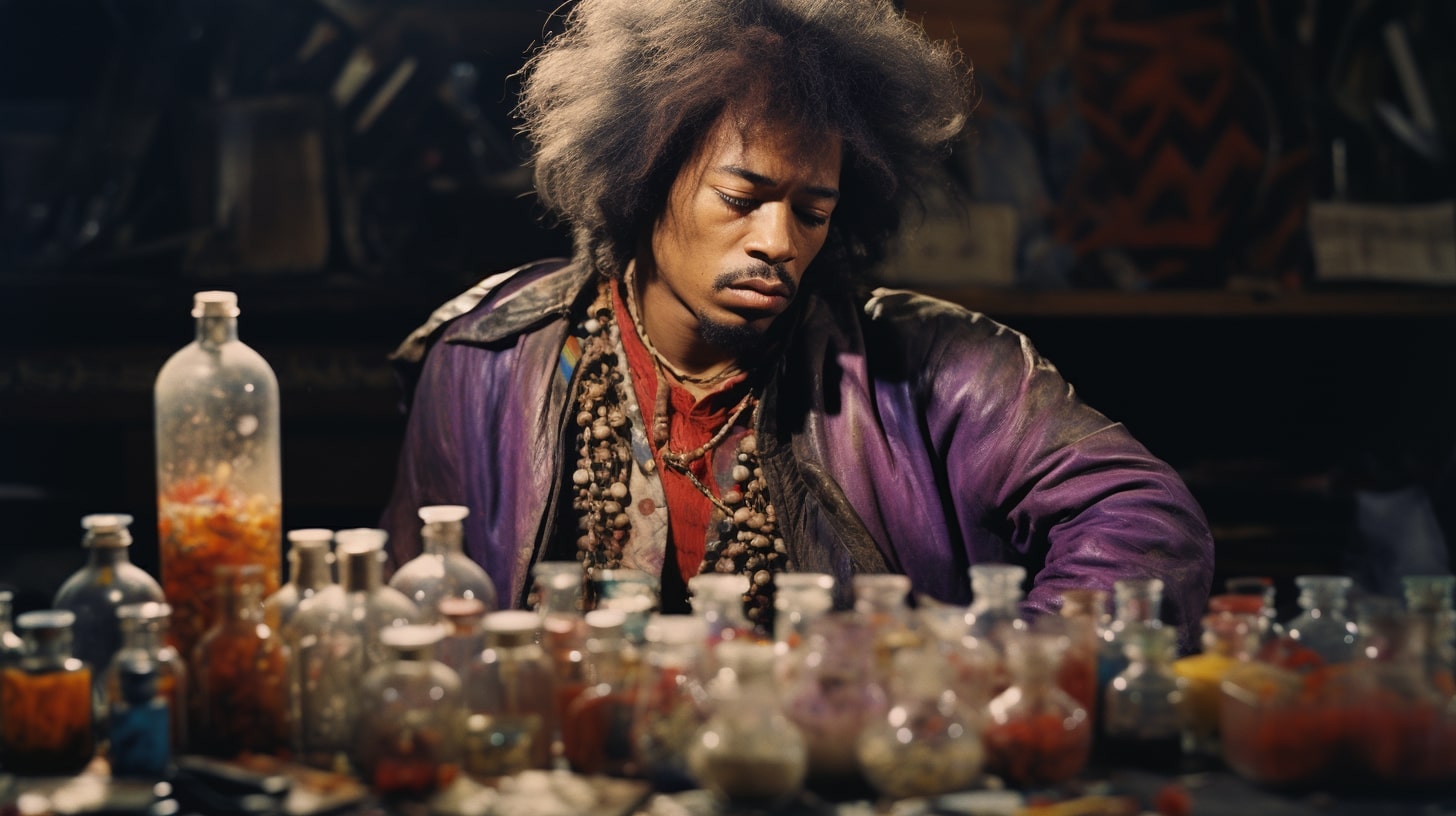Jimi Hendrix, an American rock guitarist, singer, and composer, was known for his incredible talent and innovation in electric guitar techniques. Fusing American blues, jazz, rock, and soul traditions with British avant-garde rock, he was described by the Rock and Roll Hall of Fame as “arguably the greatest instrumentalist in the history of rock music.” Hendrix’s life was unfortunately cut short on September 18, 1970, when he died in London at the age of 27.
As this tragic event unfolded, it left fans and the music industry mourning the loss of a true icon whose legacy continues to live on and inspire countless musicians.
Contents
Circumstances Surrounding His Death
Cause of Death
Jimi Hendrix, one of the most influential guitarists in the history of rock music, passed away in London on September 18, 1970, at the age of 27. The primary cause of his death is choking on his vomit after an overdose of barbiturates, a class of sedatives. The overdose caused asphyxia, which, combined with the inability to clear his airway, led to his tragic demise.
Inquest Findings
An inquest into Hendrix’s death was conducted to ascertain the circumstances surrounding his passing. The inquest returned an open verdict, a conclusion that does not specifically determine the precise cause of death. The lack of a definitive verdict has fueled speculation and debate about the events that led to Hendrix’s untimely death.
Some of the factors examined during the inquest included:
- Hendrix’s poor health in the days preceding his death was attributed to fatigue, lack of sleep, and overwork.
- The absence of a suicide note and any indication that Hendrix may have intentionally taken his own life.
- The possibility of foul play, given the unusual circumstances around his death.
Conspiracy Theories
The unresolved nature of the inquiry and the open verdict has given rise to several conspiracy theories concerning Jimi Hendrix’s passing. Among the most notable conspiracies is the allegation that he may have been murdered. Former road manager, James ‘Tappy’ Wright, claimed that Hendrix’s manager, Mike Jeffrey, admitted to arranging Hendrix’s murder to collect insurance money. However, these claims have never been substantiated, and their validity remains uncertain.
Other conspiracy theories focus on the possibility of Hendrix being the victim of a mysterious, powerful force or deliberate poisoning. These theories are largely speculative and not based on concrete evidence that could hold up to scrutiny.
In the absence of concrete evidence, the official cause of Jimi Hendrix’s death remains listed as asphyxia due to choking on his own vomit following an overdose of barbiturates.
His Final Months
Electric Lady Studios
In the months leading up to his death, Jimi Hendrix spent a significant amount of time at Electric Lady Studios, a recording studio he had built in New York City. The studio allowed him to experiment with new sounds and techniques, pushing the boundaries of his music. During this time, he collaborated with various musicians, including his former bandmate from Little Richard’s group, Billy Cox.
Band of Gypsys
In search of a new musical direction, Hendrix formed the short-lived group Band of Gypsys, which included Buddy Miles on drums and Billy Cox on bass. They played a few shows together, most notably a legendary Pew Year’s Eve 1969 performance at the Fillmore East. The Band of Gypsys showcased a more funk- and soul-influenced sound, and their performances were well-received by fans and critics alike.
Cumberland Hotel
Jimi Hendrix’s final days were spent in London, where he stayed at the Cumberland Hotel. He was accompanied by his girlfriend Monika Dannemann, and a close friend, Devon Wilson. In these final days, Hendrix struggled with sleep, fatigue, and a chronic lack of rest.
On the night of September 17, 1970, Hendrix took several sleeping pills that were prescribed to Dannemann. Unfortunately, the dosage he took was far beyond the recommended amount, leading to his untimely death on September 18.
The Final Moments of Jimi Hendrix
Samarkand Hotel
The legendary guitarist Jimi Hendrix spent his final moments at the Samarkand Hotel in London. On September 18, 1970, at the age of 27, Hendrix tragically passed away. The exact circumstances surrounding his death remain a subject of speculation, but it is generally believed that his demise was the result of asphyxiation stemming from vomit inhalation. It occurred after he had taken an excessive amount of sleeping pills.
Monika Danneman
Monika Danneman, a German figure skater, and artist, was Jimi Hendrix’s girlfriend up until the time of his death. She discovered Hendrix unconscious in their shared Samarkand Hotel room and immediately called for an ambulance. However, it was too late. Hendrix was pronounced dead shortly after he arrived at St. Mary Abbot’s Hospital. While Monika Danneman’s accounts of the events surrounding Hendrix’s death have varied over the years, she consistently maintained that he was in poor health during their time together, contributing to the tragedy.
Michael Jeffery
Michael Jeffery was Jimi Hendrix’s manager and has been the subject of several conspiracy theories surrounding the musician’s death. Some have claimed that Jeffery orchestrated the incident for financial gain, but evidence supporting these claims has never materialized. These rumors grew partly due to Jeffery’s alleged involvement with the CIA and connections in the underworld, but there is no concrete evidence to suggest that he played a role in Hendrix’s tragic fate.
Controversies After His Death
Paternity Case
In the years following Jimi Hendrix’s death, a paternity case involving a Danish woman named Kirsten Nefer came to light. Nefer claimed that Hendrix was the father of her child, born in 1967. The case drew attention and debate, as it was difficult to establish the truth of the claim due to the lack of DNA testing at that time. A Rotterdam court ultimately dismissed Nefer’s claims, but the controversy surrounding Hendrix’s paternity continues to linger.
Recording Contract Dispute
Another controversy after Hendrix’s death was a dispute over his recording contract. This disagreement involved a producer by the name of Alan Douglas and a journalist named Sharon Lawrence. The dispute centered on the ownership of rights to unreleased Hendrix music and the direction of Hendrix’s posthumous music releases. Ultimately, the dispute led to ongoing legal battles and disputes among various parties interested in Jimi Hendrix’s music and legacy.
Career and Achievements
Influences and Early Life
Jimi Hendrix was born on November 27, 1942, in Seattle, Washington. His early influences encompassed various musical genres, including rock and roll, blues, jazz, and soul. Notable artists that inspired him were Sam Cooke and The Isley Brothers. Hendrix’s passion for music grew throughout his childhood and teenage years, eventually leading to the beginning of his career as a guitarist and singer.
Breakthrough and Rise to Fame
Hendrix’s big break came in 1966 when he moved to London and was discovered by Chas Chandler, a member of The Animals. Chandler became his manager and formed The Jimi Hendrix Experience, a three-member group, with Hendrix on guitar and lead vocals, Noel Redding on bass, and Mitch Mitchell on drums. The band’s distinctive blend of blues, rock, and soul began attracting significant attention within the London music scene.
In December 1966, Hendrix released his first single, “Hey Joe,” which became an instant hit. Later on, in 1967, the band released their debut album, “Are You Experienced?” featuring iconic tracks such as “Purple Haze” and “The Wind Cries Mary.” The album’s groundbreaking sound firmly placed Hendrixon on the map and garnered critical acclaim from the Beatles and Eric Clapton.
Notable Performances
Throughout his short-lived career, Hendrix delivered some memorable live performances that cemented his status as a legendary guitarist. These include:
- Monterey Pop Festival (1967): Hendrix’s US debut, where he famously set his guitar on fire during a performance of “Wild Thing.”
- Woodstock (1969): Hendrix played an unforgettable rendition of the U.S. national anthem, “The Star-Spangled Banner,” which became symbolic of the festival and an entire generation.
- Isle of Wight Festival (1970): His last major performance before his untimely death later that year.
Signature Songs
Jimi Hendrix’s profound impact on rock music is reflected in his wide-ranging discography filled with groundbreaking tracks. Some of his signature songs include:
- “Purple Haze”: A psychedelic rock anthem featuring innovative guitar techniques and poetic lyrics.
- “Hey Joe”: A blues-rock ballad that showcased Hendrix’s storytelling prowess.
- “The Wind Cries Mary”: A tender, introspective song reflecting on a past relationship.
These songs, as well as many others from his catalog, continue to influence and inspire musicians around the world.
Jimi Hendrix’s Legacy
Influence on Music
Jimi Hendrix, an American rock guitarist, singer, and composer, had a profound and lasting impact on the music world. He was known for fusing American traditions of blues, jazz, rock, and soul with British avant-garde techniques to create a unique and groundbreaking sound. As one of the most influential guitarists of the 1960s, Hendrix was described by the Rock and Roll Hall of Fame as “arguably the greatest instrumentalist in the history of rock music.” His innovative style and energetic performances continue to inspire musicians today.
Posthumous Releases
After Hendrix’s untimely death in 1970, many of his songs were released posthumously, including the album “First Rays of the New Rising Sun,” which showcased the direction he was heading in before his passing. The release of these songs further solidified Hendrix’s position as a legendary musician and his influence on the music industry.
Memorials and Tributes
Jimi Hendrix’s legacy has been commemorated through various memorials and tributes over the years. One tribute to his enduring impact was when he received a star on the Hollywood Walk of Fame in November. In his hometown of Renton, Washington, Hendrix was laid to rest in Greenwood Cemetery, a place where fans can pay their respects to the iconic musician. Numerous artists have also cited Hendrix as an inspiration, and his music continues to be celebrated in the world’s popular culture.


